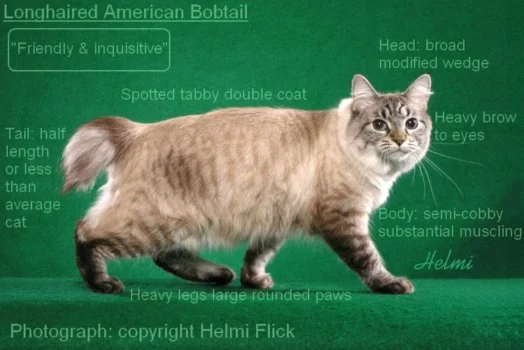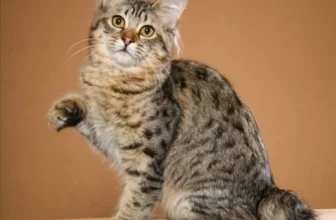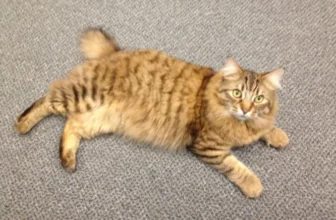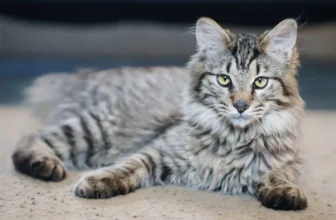The American Bobtail is a fascinating breed of cat that has captured the hearts of many pet owners. But have you ever wondered about the impact of the environment and climate on the evolution of this beloved feline? From the frigid winters of Alaska to the scorching deserts of Arizona, the American Bobtail has adapted to a range of environments with unique physical and personality traits. In this article, we explore the effect of environment and climate on the evolution of the American Bobtail, examining how these factors have shaped the breed both in the past and present. So, grab a cup of coffee and get ready to discover the surprising ways that environment and climate have influenced one of America’s most beloved cat breeds.
The Environment and American Bobtail Evolution
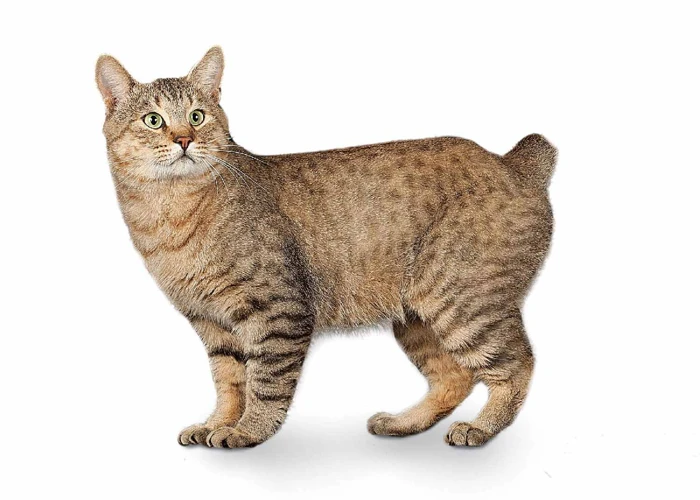
As one of the most popular feline breeds in the United States, American Bobtails are known for their unique physical characteristics and remarkable personalities. These cats have evolved over time to adapt to their environment and changing climate. The origins of the American Bobtail can be traced back to a group of feral cats that were discovered in Arizona. From there, the breed spread across the country and began to develop traits that helped them thrive in various environments. In this article, we will explore how the environment and climate have influenced American Bobtail evolution, from their adaptations to cold and desert climates to the impact on their physical and personality traits. We’ll also examine the potential implications for future evolution. To learn more about the origins of this fascinating breed, check out our article on American Bobtail Origins.
Origins of the American Bobtail
The American Bobtail is a unique breed of cat with origins dating back to the 1960s. Unlike many other breeds that have been around for centuries, the American Bobtail is a relatively new breed that was created through selective breeding. The breed was first developed in the United States, where breeders wanted to create a cat with a wild appearance, while also being friendly and affectionate towards humans.
The original American Bobtail cats were a cross between a Manx and a Siamese cat. Breeders chose the Manx for its short, bobbed tail, and the Siamese for its distinctive markings and blue eyes. Over time, other breeds were introduced into the breeding program, including the Himalayan and the Persian, to help further refine the American Bobtail breed.
Today, American Bobtails are recognized by many cat registries, including The International Cat Association (TICA), and the breed has a distinct breed standard that outlines the physical characteristics that make an American Bobtail a purebred cat. Some of the distinctive characteristics of the American Bobtail include their short, tufted tails, muscular build, and wild, untamed appearance.
Although American Bobtails are a distinct breed, they share some similarities with other breeds. For example, the Manx and the American Bobtail both have short tails, while the Maine Coon and the American Bobtail share similar facial features. Despite these similarities, the American Bobtail is a unique breed that has come to be known for its playful, curious nature and its affectionate disposition.
As with many cat breeds, the environment and climate played a role in shaping the evolution of the American Bobtail. In the following sections, we will explore some of the ways that the American Bobtail has developed to thrive in different environments, including cold and desert climates.
Adaptations to Cold Climates
The American Bobtail is a breed of cat that has adapted to various climates throughout North America, including cold regions. These cats are well-equipped to survive in colder temperatures due to their unique physical characteristics, thick fur, and larger body size.
Fur and Coat Length: The American Bobtail has a thick and dense coat that helps to insulate them from the cold. The fur is also longer in some regions, such as the belly, to provide extra warmth. In colder climates, American Bobtails may have a thicker and softer undercoat to provide additional insulation against the harsh weather. This adaptation has allowed them to withstand the colder temperatures in regions such as Alaska and Canada.
Tail Shape and Length: The tail of the American Bobtail is an essential adaptation for survival in colder climates. Their tail is shorter than that of most cats, and it is also covered in thicker fur. This adaptation allows them to curl up in a ball, wrapping their tail over their body for extra warmth. The shorter tail also prevents the heat from escaping and keeps them warm in cold climates.
Eye Color and Shape: The American Bobtail’s eyes have a unique shape and color that aid in their survival in cold regions. Their eyes are large and round, allowing them to see better in low light conditions. They also have an almond-shaped design, which helps them to see better in periphery and snow glare. Additionally, their light-colored eyes reflect more light and allow them to see better in darker environments found in colder climates.
Size and Proportions: The American Bobtail is a larger cat breed, which is another adaptation to colder environments. The larger size provides more body mass, which creates extra heat and allows them to withstand lower temperatures. Additionally, their proportionally shorter legs make them better equipped to walk on top of the snow and maneuver in deep snow drifts.
The American Bobtail has adapted well to colder climates throughout North America, and their physical adaptations have allowed them to thrive in these regions. To learn more about the characteristics of the American Bobtail, you can read our American Bobtail Characteristics article. Also, the impact of crossbreeding on the evolution of the American Bobtail can be found in our Crossbreeding and American Bobtail Evolution article.
Adaptations to Desert Climates
The American Bobtail has also evolved to survive in arid environments. Its ability to adapt to the harsh conditions of the desert is a clear testimony to its resilience. The following table illustrates some key adaptations that have helped the American Bobtail thrive in the desert:
| Adaptations | Description |
|---|---|
| Paw Pads | The American Bobtail has thick paw pads that help it walk on hot sand and rock surfaces without burning its feet. |
| Water Conservation | This breed has a unique ability to conserve water, enabling it to survive in the desert where water sources may be scarce. |
| Fur Color | Their fur is usually lighter in color, which helps to minimize heat absorption from the sun’s rays. |
| Reduced Hunting | In the desert, prey can be scarce, so the American Bobtail has adapted to consume plants and small insects as a means of survival. |
These adaptations have allowed the American Bobtail to not only survive, but thrive in the harshest of environments, proving once again the resilience of this breed.
The Impact of Climate on Physical Characteristics
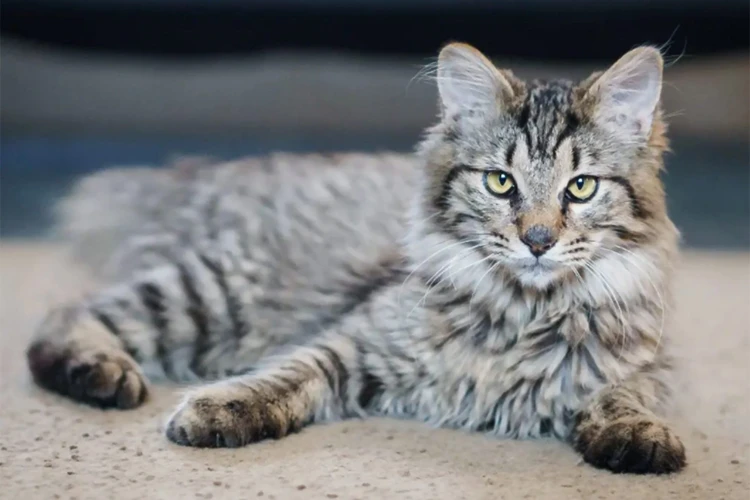
From coats to tails, the physical characteristics of American Bobtails have evolved over time as a response to the various environmental conditions they have faced. It is fascinating to discover how the breed has adapted its appearance to the surrounding climate. In this section, we will explore the influence of climate on their physical traits, shedding light on how important environmental factors have been in shaping the American Bobtail we know today.
Fur and Coat Length
The fur and coat length of the American Bobtail are heavily influenced by the environment and climate in which they live. In colder climates, their fur tends to be thicker and longer, providing better insulation and protection against harsh weather conditions. Conversely, in hotter and drier desert climates, their fur tends to be shorter and lighter to help cope with the heat.
Cold Climates
In colder environments, American Bobtails have developed long, thick fur that acts as insulation against the cold. This adaptation allows them to conserve body heat and stay warm in freezing temperatures. Their fur is also often lighter in color, which helps them to blend in with their snowy surroundings while hunting.
Desert Climates
In contrast, American Bobtails living in desert environments have adapted to the hot and dry conditions by developing shorter, lighter coats. This adaptation helps them to stay cool in the intense heat by allowing air to circulate around their bodies. Their fur is often darker in color to protect them from the sun’s harmful rays.
To illustrate how American Bobtails have adapted to different climates, here is a table showing the variations in their fur and coat lengths:
| Climate | Fur Length | Coat Thickness |
|---|---|---|
| Cold | Long | Thick |
| Temperate | Medium | Moderate |
| Desert | Short | Light |
As seen in the table, American Bobtails living in different climates have adapted to their surroundings by developing different fur and coat characteristics, allowing them to survive and thrive in their environments.
Tail Shape and Length
The environment and climate play a significant role in the development and evolution of the American Bobtail. One notable feature affected by these factors is the shape and length of their tails.
Tail Shape: The American Bobtail’s tail is one of its most distinctive features, and it varies in shape depending on its environment. For instance, bobcats living in colder climates like the mountains typically have shorter tails with more fur to keep them warm. Meanwhile, those living in the desert have tails that are longer and less bushy due to the high temperatures in the region.
| Environment | Tail Shape |
|---|---|
| Cold Climates | Shorter and bushier |
| Desert Climates | Longer and less bushy |
Tail Length: The length of the American Bobtail’s tail is also impacted by environmental factors. Bobcats living in areas with dense forests or rocky terrain have shorter tails to help them maneuver through tight spaces. In contrast, those living in open grasslands or low vegetation areas have longer tails to assist them in balance and stability while hunting.
| Environment | Tail Length |
|---|---|
| Forests or rocky terrain | Shorter |
| Open grasslands or low vegetation areas | Longer |
In addition to shape and length, the American Bobtail’s tail is also used as a form of communication. When they are happy and content, their tail stands tall and still. But when in a state of fear or aggression, the tail fluffs up to make the bobcat look bigger and more intimidating.
The environment and climate have a significant impact on the shape and length of the American Bobtail’s tail. Their ability to adapt to these changes ensures their survival and successful advancement in evolution.
Eye Color and Shape
One notable physical characteristic of American Bobtails affected by their environment and climate is their eye color and shape. Due to their adaptations to different climates, American Bobtails can have a range of eye colors, including amber, gold, green, and blue. Additionally, the shape of their eyes can vary depending on their environment.
The Impact of Cold Climates: In colder climates, American Bobtails may have smaller, more slanted eyes to protect them from the harsh winds and snow. Their eyes may also be a lighter color to reflect more light, aiding in vision during snowy conditions.
- In cold climates, American Bobtails may have smaller, slanted eyes
- Their eyes may be a lighter color to reflect more light
The Impact of Desert Climates: In warmer, drier climates, American Bobtails may have larger, more round eyes to help them adapt to the bright sunlight and potential predators. Their eyes may also be a darker color to protect their vision from the intense desert sun.
- In warmer, drier climates, American Bobtails may have larger, rounder eyes
- Their eyes may be a darker color to protect their vision from intense sunlight
The environment and climate in which an American Bobtail lives can greatly impact their eye color and shape, allowing them to better survive in their natural surroundings.
Size and Proportions
The American Bobtail is a medium-sized breed of cat that has a unique body structure, thanks to its environment and climate. The breed is known for its muscular body, broad shoulders, and sturdy legs.
One of the significant impacts of the environment and climate on the American Bobtail’s evolution is the size and proportions of its body. These cats are known for their robustness and agility, making them great hunters in the wild. As a result, they have a substantial and athletic build, which is entirely in line with their natural habitat.
In cold climates, American Bobtails have adapted to have a large and round head, which reduces heat loss in cold environments by minimizing the area through which heat escapes. This adaptation also plays a role in making the cat appear more massive. Additionally, their ears are also relatively small to help maintain warmth. In contrast, American Bobtails inhabiting warmer regions have larger ears to facilitate heat management.
The American Bobtail’s hind legs are slightly longer than their forelimbs, giving them the advantage of leaping high and far. These proportions also allow them to move quickly and with agility as they rise on their hind legs during stalking and hunting. The length of their tail plays a significant role in their balance and helps improve their agility when navigating their surroundings.
The size and proportions of the American Bobtail’s body are a testament to the breed’s evolution and adaptation to its natural habitat. As the cat continues to evolve over the years, it will be fascinating to see how the environment and climate continue to shape its body structure over time.
The Impact of Climate on Personality Traits
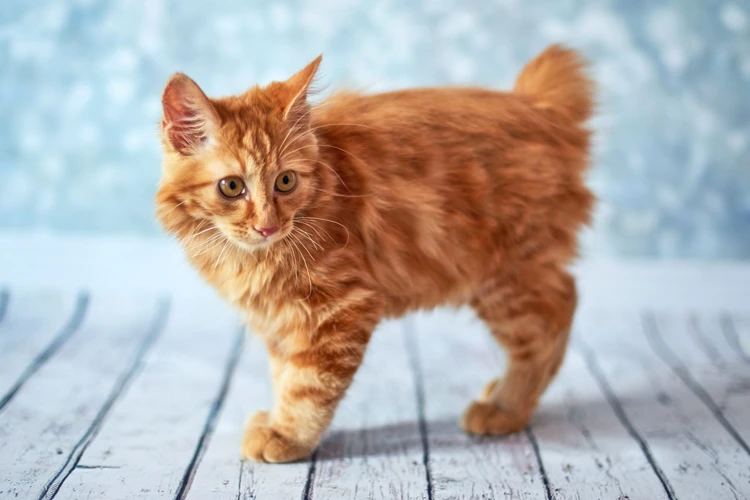
As fascinating as the physical changes that have occurred in the American Bobtail may be, they are not the only result of evolving in diverse environments. The climate has also influenced their personality traits, behavior, and interactions with humans. The American Bobtail’s environment and the unique challenges it presents have shaped the breed’s disposition, hunting skills, and sociability. In this section, we will explore the impact of climate on American Bobtail’s personality traits and how it influences their behavior and interactions with humans.
Temperament and Disposition
The temperament and disposition of the American Bobtail cat have been shaped by the environment in which they evolved. Due to their adaptation to a variety of climates, the breed has developed a unique personality characterized by independence, intelligence, and affection towards their owners.
1. Independent: American Bobtails are known for being independent and self-sufficient, which stems from their wild ancestors who had to fend for themselves in harsh environments. They are not particularly needy cats and can entertain themselves for hours on end, which makes them ideal pets for busy owners.
2. Intelligent: The American Bobtail is a highly intelligent breed, which makes them easy to train and teach tricks too. They are curious and interested in their surroundings, which can sometimes get them into trouble. Due to their intelligence, they require mental stimulation and regular exercise to prevent boredom and destructive behavior.
3. Affectionate: Despite their independent nature, American Bobtails are also known for their affection towards their owners. They bond strongly with their families and are known for being loyal and protective of their loved ones. They often follow their owners around the house and enjoy cuddling and being petted, which makes them great companions.
4. Playful: American Bobtails have a playful streak that is attributed to their wild ancestry. They are active and enjoy playing with toys and other cats or even dogs. Their playful nature makes them great pets for families with children as they are patient and love to play.
The temperament and disposition of the American Bobtail cat have been heavily influenced by the harsh environments in which they evolved. Their independence, intelligence, and affectionate nature make them unique and lovable pets. Regular exercise and mental stimulation are essential for the health and wellbeing of the breed, which should be taken into consideration when choosing to bring an American Bobtail into your home.
Hunting and Surviving
The American Bobtail’s hunting and survival instincts have been shaped by their environment and climate over time. Their ability to adapt to different hunting conditions and climates has allowed them to thrive and survive in various regions. Below is a table highlighting some of the key hunting and survival characteristics of the American Bobtail:
| Hunting and Survival Traits | Description |
|---|---|
| Ambush Hunting Technique | The American Bobtail’s muscular and athletic build enable them to hide and pounce on their prey with great speed and agility. Their stubby tails also allow them to balance and make sudden changes in direction while hunting, making them effective ambush predators. |
| Excellent Climbers | The American Bobtail’s agile and muscular build makes them excellent climbers. They can climb trees and large rocks with ease, allowing them to reach prey and escape danger quickly. |
| Sharp Hunting Instincts | Due to their hunting and survival instincts, the American Bobtail is an excellent hunter. They are known to chase down rodents, birds, reptiles, insects, and other small prey with precision and accuracy. |
| Highly Adaptable | The American Bobtail’s ability to adapt to different hunting conditions and climates make them successful survivalists. They can thrive in both cold and warm environments and have developed unique hunting techniques to suit different terrains. |
| Self-Sufficient | The American Bobtail is an independent breed that prefers to hunt and survive on their own. They have been known to hunt and catch their own food, which has made them a popular choice for farmers and ranchers as they help to keep rodent populations in check. |
The American Bobtail’s hunting and survival abilities have been shaped by their environment and climate. Their adaptation to different terrains and ability to thrive in various environments has allowed them to evolve and develop unique hunting techniques making them successful survivalists.
Interacting with Owners
Strong bonds between American bobtails and their owners are the result of the breed being domesticated over the years. These cats are very social and thrive in environments with consistent human interaction. They are also known to show a high level of loyalty to their owners, making them great pets for families.
| Interaction Type | Description |
|---|---|
| Playfulness | American bobtails love interactive playtime with their owners. They enjoy playing fetch, chasing toys or simply batting around ping pong balls. |
| Affectionate | These cats are known for their affectionate nature towards their owners. They are always eager to cuddle up in a lap or sit next to their owners while they watch TV. |
| Training | American bobtails are intelligent cats. They can be easily trained with positive reinforcement techniques. Teaching them tricks, such as sitting or high fives, can be a great way to bond with your feline friend. |
| Vocalization | American bobtails are not overly vocal, but they are good at communicating their needs to their owners. They will often chirp or trill to get attention or to let you know they want to play. |
| Care | American bobtails require regular grooming, such as brushing and nail trimming. This grooming time can be an opportunity for bonding between owner and cat. It’s also important to provide proper nutrition and regular vet checkups to ensure the health and happiness of your American bobtail. |
American bobtails are social and loyal cats that thrive on interaction with their owners. By providing love, attention, and regular care, you can build a strong bond with your feline friend.
Environmental Changes and Future Evolution
The American Bobtail cat has been able to adapt to various environmental changes throughout history, but as the world continues to evolve, many wonder what the future holds for this unique breed. With global warming, deforestation, and other environmental issues affecting the wildlife around us, it’s important to consider how these changes will impact the future evolution of the American Bobtail.
Adaptability: One thing the American Bobtail has going for it is its adaptability. Over the years, this breed has been able to successfully adapt to cold and dry environments, thriving in both climates. As climate change continues to impact the earth, the American Bobtail may be able to adapt to new habitats and climates as well.
Genetic Changes: As the environment changes, genetic mutations may occur in the American Bobtail as well. These mutations could lead to new physical or behavioral adaptations, helping the breed to better survive in its changing environment. However, these genetic changes could also lead to negative effects, such as an increase in genetic disease or a decrease in available mates due to habitat loss.
Conservation Efforts: To ensure the survival of the American Bobtail breed in the face of environmental changes, conservation efforts should be undertaken. Preservation of natural habitats, reduction of deforestation, and limiting greenhouse gas emissions are all important steps towards protecting the environment that the American Bobtail and other wildlife depend on for survival.
Selective Breeding: Another potential method of ensuring the survival and future evolution of the American Bobtail is through selective breeding. Breeders could choose to selectively breed for certain physical or behavioral traits that may be beneficial for the breed to survive in a changing environment. However, this method should be approached with caution, as overbreeding or breeding for specific traits could result in negative effects for the breed.
The future evolution of the American Bobtail is uncertain, as much will depend on how the environment continues to change. However, through efforts such as conservation and selective breeding, we can help to ensure that this unique breed has the best chance for survival and continued adaptation in the face of environmental challenges.
Conclusion
After examining the impact of environment and climate on American Bobtail evolution, it is apparent that these factors have played a significant role in shaping the physical and behavioral characteristics of the breed. The adaptations that the American Bobtail has made to survive in different climates are a testament to their incredible resilience and ability to thrive in diverse environments.
The American Bobtail’s thick coat and bushy tail, along with their stocky build, have helped them withstand colder temperatures, while their large, expressive eyes assist with hunting in low-light conditions. On the other hand, their shorter and more streamlined bodies make them better suited for hotter and drier climates.
It’s also evident that the American Bobtail’s personality traits, such as their affectionate nature and strong hunting instincts, have been heavily influenced by their environment. As a result, breeders should take into account these traits when breeding and selecting cats for specific environments, to successfully continue the genetic evolution of the breed.
However, it’s essential to acknowledge that the environment and climate are not static, and future changes may impact the American Bobtail’s evolution further. Therefore, we must continue to study and understand how environmental changes affect the breed’s genetics and behavior to adapt to new conditions successfully.
In conclusion, the environment and climate have played a crucial role in shaping the American Bobtail breed. Through natural selection and genetic adaptation, these cats have developed unique physical and behavioral traits that make them well-suited for different environments. As we continue to observe and understand the impacts of environmental changes on this breed, we can ensure that it continues to thrive and evolve in the future.
Frequently Asked Questions
What is the American Bobtail?
The American Bobtail is a breed of domestic cat with a short, stubby tail and a muscular, athletic build.
Where did the American Bobtail originate?
The exact origins of the American Bobtail are unknown, but it is believed to have developed naturally in North America.
What are some adaptations the American Bobtail has made to cold climates?
The American Bobtail has a thick, insulating coat and long fur around its paws for warmth in colder climates.
What are some adaptations the American Bobtail has made to desert climates?
The American Bobtail has a shorter coat and a broad, powerful build to help it endure the hot, dry conditions of desert climates.
How does climate affect the fur and coat length of the American Bobtail?
Cold climates tend to produce longer, thicker coats on the American Bobtail, while warmer climates lead to shorter coats.
What is the significance of the American Bobtail’s tail shape and length?
The American Bobtail’s tail length and shape are important adaptations for balance and hunting, as well as a distinguishing feature of the breed.
What impact does environment have on the American Bobtail’s temperament?
The American Bobtail’s temperament is influenced by its environment and can vary from laid-back and friendly to cautious and aloof.
How does the American Bobtail’s hunting behavior vary by climate?
The American Bobtail’s hunting behavior adapts to its environment, with cats in colder climates hunting more frequently and cats in warmer climates focusing on conserving energy.
Can the American Bobtail make a good pet?
Yes, the American Bobtail can make a loving and loyal pet for the right owner with proper care and attention.
Will the American Bobtail continue to evolve in response to environmental changes?
Yes, the American Bobtail and other animals will continue to evolve as their environment changes, adapting to ensure the survival of the species.

